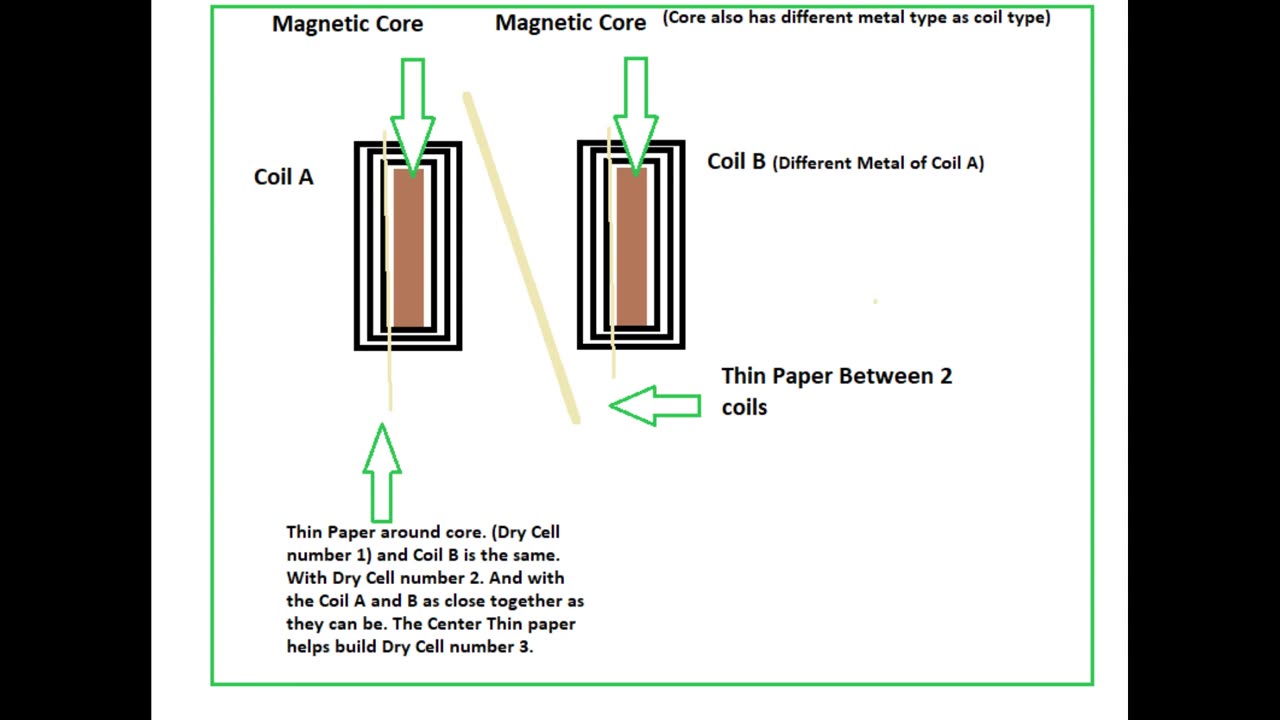Premium Only Content

Self Powered Inductive Kickback
My invention is a simple, low-cost, self-oscillating system that harnesses the back EMF of two coils to produce a sharp spike of energy that can be used to power devices or charge batteries.
The system uses only a few components to trigger the feedback loop, including a low voltage zener diode and an SCR (silicon-controlled rectifier) to dump the charge of a flash capacitor into one of the coils.
In details, The system is powered by three dry cells, with two of them being integrated into the coils themselves. The coils are wound around magnetic cores, with a thin paper layer in between to act as a dry cell. This setup creates a total of three dry cells, which, when run in series, produce a few volts of power that can be fed back into the system for a back EMF feedback loop. and an SCR diode is used to dump the charge from the capacitor into one of the coils, causing a back emf spike that triggers the system to oscillate. The dry cell acts as a power source, while the coils generate a back electromotive force (emf) due to their magnetic fields. The system is designed to operate as a self-triggering feedback loop, with the triggering voltage of the SCR adjusted based on the output voltage of the coils. The dry cell properties of the coils also create an internal capacitance, which helps the system during "off" times
The addition of a metal core to each coil, with a thin paper insulator between the core and the coil, creates a dry cell effect within the system, effectively doubling the power output of the generator. This is due to the metal cores acting as an anode and cathode, with the thin paper insulator acting as the electrolyte. The voltage generated by the coils and dry cell effect can be added together to create a larger voltage for the flash capacitor to discharge. By using the magnetic cores as dry cells in addition to the paper, the voltage difference between the two coils can be increased, creating a larger voltage output.
It's important to clarify that the "dry cell" in this invention is not a traditional dry cell battery that we commonly use in electronics. Instead, it refers to the phenomenon of creating a voltage potential using a metal core and a thin paper insulator as an electrolyte.
This phenomenon occurs due to the presence of moisture in the air. The thin paper insulator, which is typically made of cellulose, is hygroscopic, meaning it readily absorbs moisture from the air. When this moisture comes into contact with the insulator, it creates a conductive path between the metal core and the coil, allowing for the flow of electrical current.
As the generator operates and produces back emf, the dry cells become charged, providing additional power to the system. This helps to ensure that the generator can continue to operate, even when the dry cell battery runs low or is depleted. When an alternating current flows through one coil, it generates a magnetic field that fluctuates in strength and direction. This fluctuating magnetic field induces an alternating current in the second coil, which is placed in close proximity to the first coil. This phenomenon is known as mutual induction.
The back emf feedback loop is an essential part of the generator, as it allows the system to continue generating power without the need for an external power source. By carefully tuning the values of the components involved, a stable and efficient feedback loop can be established, resulting in a steady stream of electrical power.
To ensure a stable oscillation, a compensator voltage system can is implemented to adjust the triggering voltage of the SCR based on the output voltage of the coils. This helps maintain a consistent feedback loop, allowing the system to operate continuously.
this system is a promising approach to harnessing the energy of back EMF for practical applications. The use of dry cells integrated into the coils themselves, along with the addition of the paper layer, provides a simple and effective way to generate power and trigger the back EMF spikes. With further development and optimization, this system could have a wide range of potential applications in areas such as renewable energy, wireless power transmission, and more. This is why I feel like I must share my research as I go along.
Forum:
http://typeright.social/forum
Please Help Support My Research: https://youtu.be/pYXETBB40j0
-
 17:59
17:59
Joel Lagace
10 months ago $0.13 earnedModern Moray Generator
2855 -
 LIVE
LIVE
Anthony Rogers
1 day agoAnthony Rogers Show - 24/7 Stream
458 watching -
 2:11:55
2:11:55
Total Horse Channel
15 hours ago2025 CMSA Extravaganza | Mounted Shooting
42.3K1 -
 4:50:33
4:50:33
VapinGamers
6 hours ago $3.09 earnedGedonia 2 - Early Release Preview and Co-Stream! - !game #Sponsored
47K -
 1:32:39
1:32:39
Glenn Greenwald
11 hours agoWeek in Review: Trump's Tariffs, Ukraine Negotiations, Possibility of War with Iran, and More with Glenn Greenwald, Lee Fang, & Michael Tracey | SYSTEM UPDATE #438
135K58 -
 5:01:00
5:01:00
EnDuEnDo
5 hours ago🚨Vairety Stream 🎮 Push to 500 Followers 🚀 Chill Vibes 😎
23.2K1 -
 4:25:53
4:25:53
Nerdrotic
11 hours ago $37.35 earnedMarvel Is SCREWED | Daredevil Afterbirth | G20 is ABSOLUTE Cinema - Friday Night Tights 349 w MauLer
140K32 -
 56:03
56:03
BonginoReport
10 hours agoICE Boss Wants Deportations To Run like Amazon Prime - Nightly Scroll w/Hayley Caronia (Ep.25)
140K85 -
 45:12
45:12
Sarah Westall
7 hours ago“Most Important Story of the Decade” Globalists Move to Fund World Gov w/ Alex Newman & Sam Anthony
70.5K13 -
 16:23
16:23
China Uncensored
8 hours agoChina STRIKES BACK Against Trump Tariffs
36K8